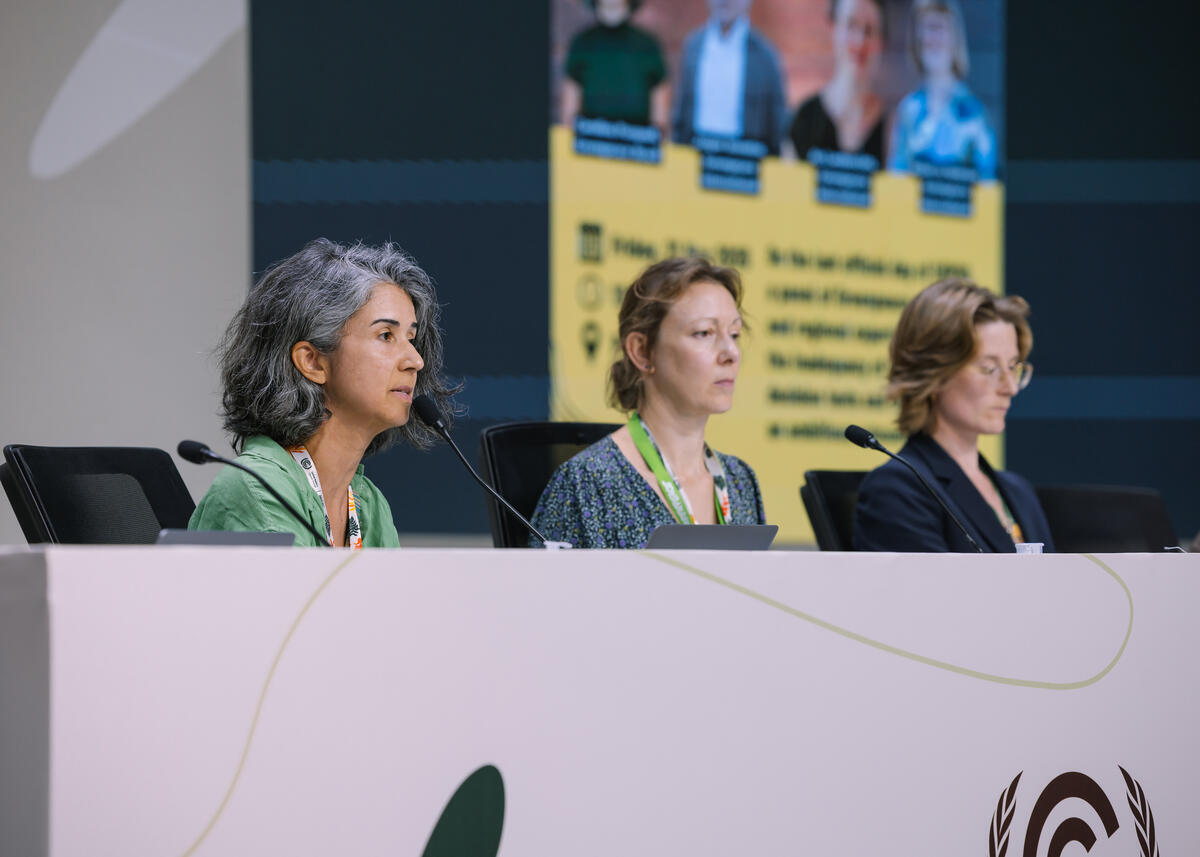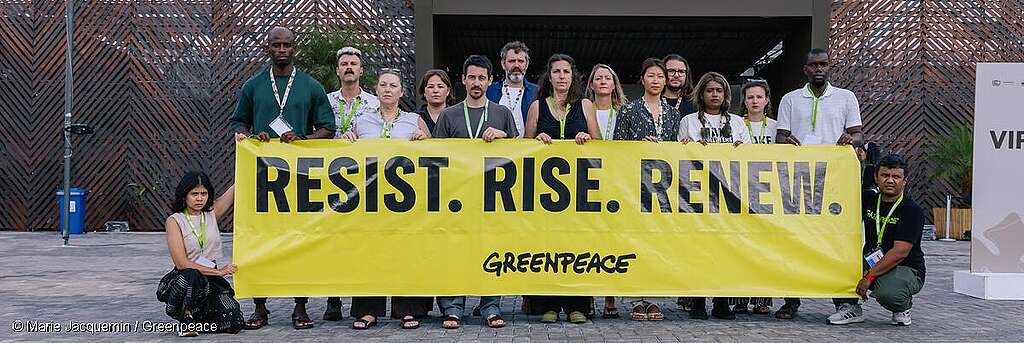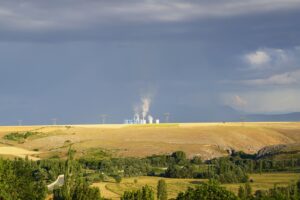Mental health problems induced, in part, by climate change are becoming increasingly common as the world warms, including the number of people experiencing “ecological grief”.
Ecological grief is one of the emotional responses seen in those living with the impacts of climate change-induced extreme weather events, such as floods, droughts or heatwaves.
In addition to crop failures due to extreme weather, individuals can experience ecological grief in response to declining yields and other changes, particularly where this directly impacts their lives and livelihoods.
This is particularly true of those in the global south, who are disproportionately affected by climate change, despite historically contributing less to the problem.
In a recent study of farmers in the Upper West Region of Ghana, I looked at how the grief caused by ecological loss can manifest in multiple ways, including causing mental health and psychosocial problems ranging from emotional distress to anxiety, depression, helplessness, hopelessness and sadness.
This research shows the potential for including ecological grief and other mental health impacts in the strategies of countries – especially those in the global south – looking for ways to adapt to climate change.
What is ecological grief?
As people increasingly live with the impact of climate change, research has tried to identify the impact it has on people’s lives.
For example, people who have been exposed to life-threatening extreme climate events are at a considerable risk of developing post-traumatic stress disorder as a result. Symptoms of this include flashbacks of the event, increased reactivity and avoidance of cues to the memory of the event.
In addition to this, several new concepts for climate change-induced distress have been introduced, to describe the long-term emotional consequences of anticipated or actual environmental changes.
Ecological grief refers to the mourning of ecological losses, including loss of species, ecosystems and meaningful landscapes, often shaped by acute or chronic ecological change.
The concept explains grief experienced in response to actual or anticipated losses in the natural world. This mourning of the loss of ecosystems, landscapes, species and ways of life has become a frequent lived experience for people around the world.
In 2018, a study published in Nature provided a conceptual clarification and understanding of climate change-induced ecological grief. It highlighted the implications of climate change-induced ecological loss on the mental health and wellbeing of people, as well as how people respond to ecological change that has both direct and indirect effects on the natural environment.
Ecological grief provides a conceptual understanding of the lived experiences of people who retain close living, working and cultural relationships to the natural environment.
Most of these people depend almost exclusively on the natural environment for livelihood needs, such as smallholder farmers who live in poor communities in the global south.
Research gap
Despite the effects of climate change on people in the global south, there is a dearth of understanding of ecological grief within the context of developing countries.
As such, paying closer attention to climate change-driven ecological grief within the context of developing countries could inform the design of climate change response strategies, decision-making, policies and interventions at the local level.
My current research aims to understand the lived experiences of climate change-induced ecological grief in the Upper West Region, Ghana’s most climate-vulnerable region.
It identifies climate change-induced ecological losses and how farmers in the region emotionally respond to those losses. The work highlights different non-economic experiences of climate change effects, focusing on emotional and mental health dimensions, which remain a relatively unexplored area.
Ecological grief in Ghana
Farmers’ understanding of ecological grief revolves around their emotional response to the loss of their livelihoods. This reaffirms farmers’ strong connection to their environment, on which their livelihoods are predicated.
First, farmers grieve the loss of their crops to extreme climate events, such as floods, droughts, heatwaves and climate-induced pests. The grief associated with the loss of crops has almost become perennial, as these extreme climate events have become more frequent.
In interviews undertaken as part of the research, farmers compared the feeling of losing their crops with the emotional pain of losing a loved one.
Second, farmers grieve the disappearance of their indigenous seeds and genetic resources.
Local seeds have been replaced with drought-resistant seed varieties, which farmers are encouraged to adopt to provide resilience in the face of the increasing impact of climate change.
Interview responses demonstrate that the adoption of the new seeds is causing the loss of farmers’ own seed varieties, which can be freely saved, exchanged and reused yearly. With the adoption of new seed varieties, farmers are losing their genetic resources and the culture associated with it. This is becoming a great source of worry and grief for farmers in the Upper West Region of Ghana, the research shows.
Third, farmers grieve the loss of their traditional ecological knowledge that was passed down to them by previous generations. This knowledge includes their ability to predict weather patterns, know farming seasons, determine soil types, know crop varieties and select seeds, among many other areas.
Without this knowledge system, farmers cannot practice agriculture as they have done in previous generations. The culture, values, norms and beliefs of farmers are tied to their traditional ecological knowledge, which often manifests through practice.
My research suggests that farmers are no longer able to predict weather patterns and farming seasons, an emerging trend that makes them feel as though they have lost their wisdom. This makes them worry.
Another source of grief for farmers is their inability to pass on their traditional ecological knowledge to their children, the research shows. This is because their ecological knowledge is becoming worthless as a result of climate change.
Way forward
My research explored ecological grief, an under-explored area of climate change-induced mental health problems in developing countries.
Indeed, farmers in developing countries are vulnerable to prolonged mental health problems if extreme climate events continue.
Moreover, a lack of alternative livelihoods and access to mental health services greatly increases farmers’ vulnerability to climate change-induced mental health problems.
This is compounded by a social culture that prohibits help-seeking.
Further research within these spaces would enable the design of targeted strategies and the provision of mental health services in rural areas.
The post Guest post: How climate change is causing ‘ecological grief’ for farmers in Ghana appeared first on Carbon Brief.
Guest post: How climate change is causing ‘ecological grief’ for farmers in Ghana
Climate Change
Greenpeace activists arrested by police helicopter after seven-hour protest on coal ship
NEWCASTLE, Sunday 30 November 2025 — Two Greenpeace Australia Pacific activists have been arrested by specialist police on a coal ship outside the Port of Newcastle, following a more than seven-hour-long peaceful protest during Rising Tide’s People’s Blockade today.
Photos and footage here
Three activists safely climbed and suspended from coal ship Yangze 16 at around 8:00am AEDT on Sunday, halting its operations and preventing its 12:15pm arrival into the Port of Newcastle. One of the activists, who was secured to the anchor chain, disembarked safely due to changing weather conditions. The other two activists, who were expertly secured to the side of the ship and holding a banner that read: PHASE OUT COAL AND GAS, were arrested at around 3:30pm by police climbers, who landed by helicopter on the ship around 1:45pm.
At the time of writing, no charges have been laid.
It comes as two other coal ships in two days were stopped by a peaceful flotilla at the People’s Blockade of the Port of Newcastle, the world’s biggest coal port. The port has been closed for the rest of Sunday as a result.
From the shore at the People’s Blockade, Joe Rafalowicz, Head of Climate and Energy at Greenpeace Australia Pacific, said:
“The right to peaceful protest is a fundamental pillar of a healthy democracy and a basic right of all Australians. Change requires showing up and speaking out, and that’s what our activists are doing in Newcastle today.
“As the world’s third-largest fossil fuel exporter, Australia plays an outsized role in the climate crisis. Peaceful protest to call on the Albanese government to set a timeline to phase out coal and gas, and stop approving new fossil fuel projects, is legitimate and valuable. Greenpeace Australia Pacific stands by and supports our activists, and stands with all peaceful climate defenders who are advocating for real climate action at the Blockade, and all around Australia.”
—ENDS—
For more information or to arrange an interview, please contact:
Kimberley Bernard: +61 407 581 404 or kbernard@greenpeace.org
Lucy Keller: +61 491 135 308 or lkeller@greenpeace.org
Greenpeace activists arrested by police helicopter after seven-hour protest on coal ship
Climate Change
From Brazil, with love

About halfway through the most recent United Nations’ annual climate change conference, COP30 in Belém, Carolina Pasquali, my counterpart at Greenpeace Brazil, started to lose her voice. She was suffering from the kind of hoarseness that kicks in when you have been speaking so much that your vocal cords become inflamed.
Carolina’s voice may have become tired during COP30, but she never fell silent. On the last morning of COP30, at Greenpeace’s final press briefing, I found myself standing behind Carolina as a press pack swarmed her, seeking answers to what was happening.
‘Who is that woman?’ I overheard one of the 56,118 registered delegates ask another.
‘With a crowd like that, she must be the Brazilian environment minister’, was the reasoned but inaccurate answer.
With Brazil hosting COP30, and particularly given the storied history of Greenpeace Brazil as a defender of the Amazon rainforest, Carolina carried an enormous load of leadership and advocacy in the lead-up and during the event. It is no wonder her voice was feeling the strain.
I’ve had the privilege of working with Carolina as part of the Greenpeace global leadership community for a few years now, and she’s an excellent colleague—thoughtful, principled, strategic, a brilliant public speaker, and in possession of a wonderful, wry sense of humour. She’s a friend and a terrific leader whom I admire deeply.
It had been Greenpeace Brazil’s vision that emergency action to halt deforestation was core to the demands that civil society brought to the COP. Given the event’s location in the Amazon, it seemed axiomatic that the goal of phasing out fossil fuels must be accompanied by the other critical half of the climate challenge: addressing deforestation, the second-largest driver of climate change.
Late in the afternoon on the second-last day of the COP, a fire broke out in the middle of the venue, sending a huge fork of flame towards the sky. It was a terrifying moment for those present in the venue. Thankfully, due to good design, the wise use of non-flammable materials, and the rapid response of first responders, there were no fatalities or serious injuries.
In her next speech, Carolina thanked those who had fought the blaze and overseen the evacuation, for their speed and bravery. And she reflected with due gravitas, this is what humanity can do: act together in the face of an emergency—whether that be a fire in a building or our whole planet facing global heating.

As it happened, COP30 got within striking distance of delivering a response that was fit for purpose in our times of planetary emergency, with support from a critical mass of countries for formal roadmaps to end deforestation as well as transition away from fossil fuels. But the official text ultimately fell short in the final hours of negotiations. As Carolina said: ‘while many governments are willing to act, a powerful minority is not.’
In these moments of failure by politicians and negotiators, it would be easy to give in to legitimate feelings of anger and frustration; but the task before us is to appraise every moment for opportunities for momentum. And the critical mass of nations that are committed to roadmaps for ending deforestation and phasing out fossil fuels offered light amidst the gloom.
And so we follow the path. We take the chances. We think through the next phase of strategy. And onwards. As Carolina said simply, ‘the work now continues.’
I’m not only grateful for Carolina’s friendship and for Greenpeace Brazil’s steadfast dedication to tackling deforestation in the Amazon, but for the entire Greenpeace network’s shared commitment.
Greenpeace is relied on for some heavy lifting at climate COPs, and our team consisted of policy experts, campaigners and other specialists from various geographies who brought their deep policy, communications, and campaigning expertise from around the world to the event,. Our morning briefings, sharing analysis, agreeing on focus and assigning tasks for the day, were possessed of that special energy that comes from a group of many backgrounds working very long hours together in common cause.
I’ve reflected over my time with Greenpeace, that when I visit any of our offices, bases or vessels, anywhere in the world, I feel at home. I am confident that you would have the same sensation of coming home too, because if you are reading this, then you are part of Greenpeace too–you, and me, Carolina, and the tens of millions of people all over the world that share our common vision of an earth restored to flourishing.
So on we go. The work continues, in love and hope, together.


Q & A
In the aftermath of the collapse of Australia’s COP31 bid, many people have reached out to ask: What happened? Why didn’t Australia get COP31? And what now?
In the lead-up to November’s COP, nobody in Australia would have anticipated that we would not be welcoming the global climate community to Adelaide next summer. Up until the very final moment when Climate and Energy Minister Chris Bowen told reporters that Türkiye would host COP31 with Australia assuming the role of president of negotiations, hope was alive that we would clinch the deal.
I suspect that the full picture of why the COP31 bid slipped through our hands is a complex mix of factors, some of which may never come to light in the public domain. What we do know is that in the UNFCCC system, decisions on COP hosts are made by full consensus rather than voting. So, for as long as Turkiye declined to withdraw its bid, it was never a done deal.
Much will no doubt be said about whether Australia could have done more to boost our chances of securing the bid. But as I said in the immediate aftermath of the announcement, whatever the forum, whoever the President, the urgency and focus of our actions cannot change. Phasing out fossil fuels and ending deforestation must be at the core of the COP31 agenda.
The task for Chris Bowen will now be to use his role as president of negotiations to drive global emissions reductions at speed and scale consistent with the Paris Agreement.
Climate Change
Greeks Challenge EU-Backed Fish Farms Amid Environmental Concerns
The country is one of the top producers of farmed fish in the EU, which has promoted aquaculture as an environmentally sustainable option for food security within the bloc.
For Dimitris Kaleantopoulos, the mud is most disconcerting. When he sets out in his fishing boat, the waters of the Aegean Sea are clear enough for him to see quite a ways down. He says that for large patches of the shallow waters that encircle his village on the Greek island of Evia, where there were once meadows of wavering sea grass and schools of minute silver fish, there is now a thick layer of sludge. “It’s a quagmire,” he said.
Greeks Challenge EU-Backed Fish Farms Amid Environmental Concerns
-
Climate Change4 months ago
Guest post: Why China is still building new coal – and when it might stop
-
Greenhouse Gases4 months ago
Guest post: Why China is still building new coal – and when it might stop
-
Climate Change2 years ago
Spanish-language misinformation on renewable energy spreads online, report shows
-

 Greenhouse Gases2 years ago
Greenhouse Gases2 years ago嘉宾来稿:满足中国增长的用电需求 光伏加储能“比新建煤电更实惠”
-
Climate Change Videos2 years ago
The toxic gas flares fuelling Nigeria’s climate change – BBC News
-

 Climate Change2 years ago
Climate Change2 years ago嘉宾来稿:满足中国增长的用电需求 光伏加储能“比新建煤电更实惠”
-

 Carbon Footprint2 years ago
Carbon Footprint2 years agoUS SEC’s Climate Disclosure Rules Spur Renewed Interest in Carbon Credits
-
Renewable Energy5 months ago
US Grid Strain, Possible Allete Sale







